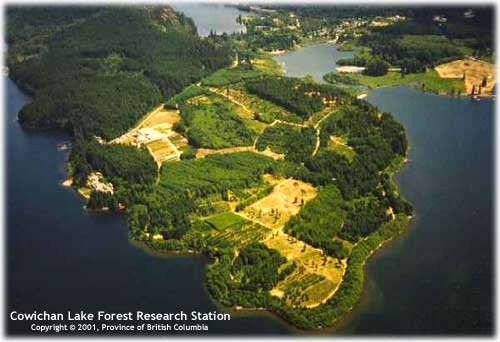
Established in 1929 by the BC Forest Service, the Cowichan Lake Experimental Station has become renown for its work in forest genetics and tree physiology. The site was chosen for its close proximity to Bald Mountain lookout tower and the presence of a considerable acreage of 20 year old ìfine, thrifty Douglas fir.î One of its first projects in 1931, shortly after the depression, was Douglas fir thinning plots. In 1935 a ìYoung MenÃs Forestry Training Planî for the unemployed, hired sixty young men who built roads and trails, a cookhouse, bunk houses and a station residence, including a telephone service and a water system.
These men were paid $1.00 a day and morale was high. There was organized recreation as well as job training activities. At the end of 1935, 10% of these men found jobs in the logging camps and sawmills. Since road access did not exist the station maintained a couple of clinker built boats equipped with outboard motors. In 1936 a road was constructed linking the Research Station and the public road.

In 1939 the personnel at CLES included 21 men in the Forest Development Project, 34 in the National Forestry Program and 15 in the Youth Forestry Training Program.
In 1941 the Station became a camp for reforestation and federal researchers. That same year a work camp was established to house conscientious objectors to war. These people developed a reputation for careful tree planting and also as fire look-outs for feared Japanese incendiary bomb devices.
In 1945 the Dominion of Canada established a field laboratory for insect and disease research and eight years later the first forest genetic experiments were begun by Dr. Alan Ewing with Douglas fir plantations.
During these early years, the Station served as a centre from which studies were conducted during the summer months. The objective of this research was to learn how best to manage forests for future use. The studies involved growth and yield, thinning, stem pruning and direct seeding. The experimental forest provided good opportunities for this and study plots were established, primarily in Douglas fir and alder stands. As well, a number of studies were done in soil mapping, site type classification and cone and seed production. Until the mid sixties and with the completion of the MinistryÃs planting program in the area, a definite camp atmosphere dominated the Station. All workers, from the foresters to the labourers, stayed in camp and used it as a base for their work.
In the 1950’s the Civil Defense Organization of the provincial government decided that the Cowichan Lake station was sufficiently remote to promote safe refuge for the Cabinet in case of a serious atomic bomb attack. The Reforestation Division was tagged with the responsibility of maintaining a large stack of canned goods at all times. It also stipulated that the stock be inventoried and replentished monthly. This inventory usually required the better part of a day for two people. Finally, in 1972, the practice was quietly eliminated and no one in Victoria ever noticed that it had come to an end.
In 1963 the nursery was established to produce stock for provenance tests and tree breeding programs. A major expansion was undertaken in 1979 and up to 25,000 grafts and 350,000 rooted cutting are grown annually. The camp and cookhouse operate on a full time basis and house training courses, Ministry work crews and visiting groups. With the closure of many logging company cookhouses, the station cookhouse is the only one of its kind in the area. In 1983 it was designated as a Forest Service Heritage Building.
From Accommodations to Restaurants, find out what to do while visiting Cowichan Lake
Cowichan Lake District Chamber of Commerce